
Slickville is a census-designated place (CDP) in Westmoreland County, Pennsylvania, United States. The population was 372 at the 2000 census.

Downtown Altoona Historic District is a national historic district located at Altoona, Blair County, Pennsylvania. The district includes 240 contributing buildings in the central business district and surrounding residential areas of Altoona. The buildings were primarily built after about 1860 and include residential, civic, social, and religious buildings. Although it does not encompass the entire downtown, it is for the most part the most urban part of Altoona's downtown district. Notable buildings include the Cathedral of the Blessed Sacrament (1920s), First Methodist Episcopal Church, First Presbyterian Church, First Evangelical Lutheran Church (1896-1897), U.S. Post Office (1931-1933), Fraternal Order of Eagles Building (demolished), Altoona City Hall, Casanave Building (1890s), Hutchison Block, McCrory's Department Store (1937), and Aaron-Penn Furniture Building. Located in the district are the separately listed Central Trust Company Buildings, Mishler Theatre, and Penn Alto Hotel.
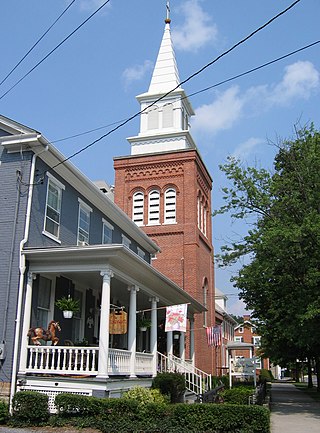
Everett Historic District is a national historic district located at Everett, Pennsylvania. The district includes 300 contributing buildings and 1 contributing object in the central business district and surrounding residential area of Everett. The buildings date between about 1830 and 1952, and include notable examples of Gothic Revival and Federal style architecture. Notable non-residential buildings include the U.S. Post Office (1938), Everett Free Library, Zion Lutheran Church, Grace Brethren Church, Barndollar Methodist Church (1860), Everett Hardware Company Building, foundry on North Juniata Street (1874), and Everett Manufacturing Company (1920-1955).
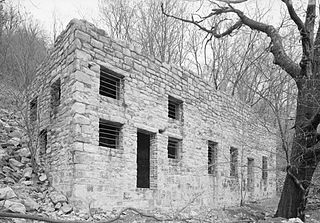
The Harbison-Walker Refractories Company is a national historic district and historic refractory brick manufacturing complex which is located in Mount Union in Huntingdon County, Pennsylvania. It originated as the Star Firebrick Company on March 7, 1865, with Articles of Association by a group of Pittsburgh and Allegheny residents.

Mount Union Historic District is a national historic district located at Mount Union in Huntingdon County, Pennsylvania. The district includes 58 contributing buildings, 3 contributing sites, and 1 contributing structure in the central business district and surrounding residential areas of Mount Union. Notable buildings include the Federal-style John Shaver House (1818), Shapiro Theater (1915), T.A. Appleby Store and House, Kenmar Hotel, Penn Central National Bank (1916), Peduzzi's and the Weller Building (1913-1914), Pennsylvania Railroad Freight Depot (1914), St. Luke's Evangelical Lutheran Church (1904-1905), First United Methodist Church (1925-1926), St. Catherine of Siena Roman Catholic Church (1912-1913), Mount Union Elementary School (1923-1924), and U.S. Post Office (1936). The contributing sites include the I.O.O.F. community cemetery, founded in 1872, and the former Victoria Park. Located in the district and listed separately is the Harbison-Walker Refractories Company complex.
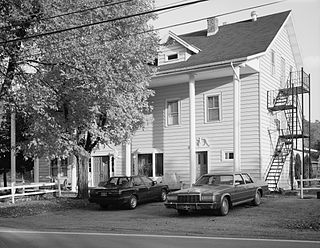
The Robertsdale Historic District is a national historic district that is located in Robertsdale in Wood Township, Huntingdon County, Pennsylvania.

Colver Historic District is a national historic district located at Barr Township and Cambria Township in Cambria County, Pennsylvania. The district includes 336 contributing buildings, 5 contributing sites, and 3 contributing structures. The district consists of residential areas, coal mining resources, Cambria and Indiana Railroad shop buildings, and a dairy farm associated with the Ebensburg Coal Company's mine and developed between 1911 and 1943. Notable buildings include a variety of brick and frame workers' housing, the Ebensburg Coal Company office building (1914), stone company store (1912), Colver Amusement Company (1912), Colver Hotel (1912), Colver Presbyterian Church (1915), public school (1927), hospital (1914), Roundhouse No. 1 (1918), Roundhouse No. 2 (1920), and main power building (1911).

The Revloc Historic District is a national historic district located at Cambria Township in Cambria County, Pennsylvania.

Berwind-White Mine 40 Historic District is a national historic district located at Richland Township and Scalp Level in Cambria County, Pennsylvania. The district includes 121 contributing buildings, 2 contributing sites, and 4 contributing structures. The district consists of a mine site and patch community associated with the Berwind-White Coal Mining Company's Eureka Mine No. 40, and developed between 1905 and the 1941. Notable buildings include over 100 two-story, frame miners' double housing, power house, drift openings, cleaning plant, motor barn, fan house, sand tank, railroad repair car shop, and wash house.
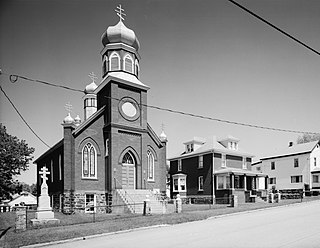
Boswell Historic District is a national historic district located at Boswell in Somerset County, Pennsylvania. The district includes 90 contributing buildings and 1 contributing site. It encompasses an area developed by the Merchant's Mining Company of Baltimore, Maryland starting in 1901. It includes the remaining extant mine resources and the archaeological remains of the mine. They consist of utilitarian industrial buildings, four types of vernacular housing, and a variety of commercial, social, and institutional buildings. Notable buildings include the First National Bank of Boswell (1919), Merchant's Coal Company office (1901), St. Stanislaus Roman Catholic Church (1918), and Sts. Peter and Paul Russian Orthodox Church (1918).

Cairnbrook Historic District is a national historic district located at Shade Township in Somerset County, Pennsylvania. The district includes 132 contributing buildings and 8 contributing structures. It encompasses an area developed by the Loyalhanna Coal and Coke Company of Philadelphia, Pennsylvania between 1912 and 1920. It includes the remaining extant mine resources and the archaeological remains of the mine. They consist of workers' housing, a variety of commercial and social buildings, and a modern draft entry mine with accompanying extractive buildings and structures. Notable buildings include the motor barn, supply house, electric substation, and Loyalhanna Coal and Coke Company Office (1914). The mine operated until 1958.

Whitsett Historic District is a national historic district located at Perry Township, Fayette County, Pennsylvania. The district includes 48 contributing buildings and 5 contributing structures in the bituminous coal mining community of Whitsett. Most of the contributing buildings were built between 1890 and 1917, and 31 of the contributing buildings are two-story, frame duplex workers housing. The oldest building is the Whitsett farmhouse, built about 1845. Other buildings and structures include three mine manager's dwellings, two brick former mine buildings, the former company store annex, the former water pumphouse, the remains of the Banning Mine No. 2 entrance, foundation of the Banning Mine No. 2 tipple complex, the mine slate dump, beehive coke oven battery, and the abandoned Pittsburgh and Lake Erie Connellsville Branch.

Star Junction Historic District is a national historic district located at Perry Township, Fayette County, Pennsylvania. The district includes 163 contributing buildings and 2 contributing structures in the bituminous coal mining community of Star Junction. Most of the contributing buildings were built between 1892 and 1918, and 130 of the contributing buildings are two-story, frame duplex workers housing. The oldest building is the Whitsett farmhouse, built about 1845. Other buildings and structures include 22 mine manager's dwellings, two former mine buildings, two churches, a parsonage, two commercial buildings, a concrete highway bridge (1921), and earthen dam reservoir.

The Shoaf Historic District is a national historic district that is located in Georges Township, Fayette County, Pennsylvania.
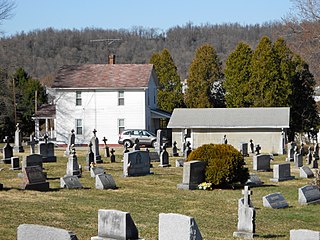
The Smock Historic District is a national historic district that is located in Franklin Township and Menallen Township, Fayette County, Pennsylvania.
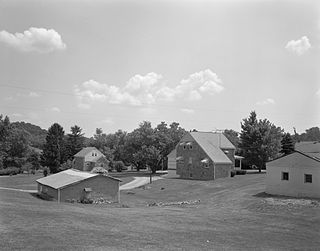
The Penn-Craft Historic District is a national historic district that is located in Luzerne Township, Fayette County, Pennsylvania.

Brier Hill is a national historic district located at Redstone Township, Fayette County, Pennsylvania. The district includes 18 contributing buildings and 75 contributing structures in the coal mining community of Brier Hill. Most of the contributing buildings and structures were built between 1902, when the community was founded, and 1937, when the mine closed. The district includes five frame double houses, the Power House, Hoist House, garage, and a number of unidentified buildings and structures.

Hannastown Farm, also known as the William Steel Farm, is a national historic district and farm which are located in Salem Township, Westmoreland County, Pennsylvania.

Vandergrift Historic District is a national historic district located at Vandergrift, Westmoreland County, Pennsylvania. It encompasses 625 contributing buildings and 2 contributing sites in Vandergrift. They were built between about 1895 and 1925, and includes a mix of residential, commercial, and institutional properties. They are in a variety of popular architectural styles including Romanesque, Queen Anne, and Colonial Revival, and laid out on a plan developed by Frederick Law Olmsted. Notable non-residential buildings include the Casino, train station, company office building, and churches. The two contributing sites are landscaped parks.

The Old Mine Road Historic District is a 687-acre (278 ha) historic district located along Old Mine Road in Sussex County and Warren County, New Jersey. It is part of the Delaware Water Gap National Recreation Area. The district was added to the National Register of Historic Places on December 3, 1980, for its significance in agriculture, archaeology, architecture, commerce, exploration/settlement, and transportation. It includes 24 contributing buildings and five contributing sites.
























